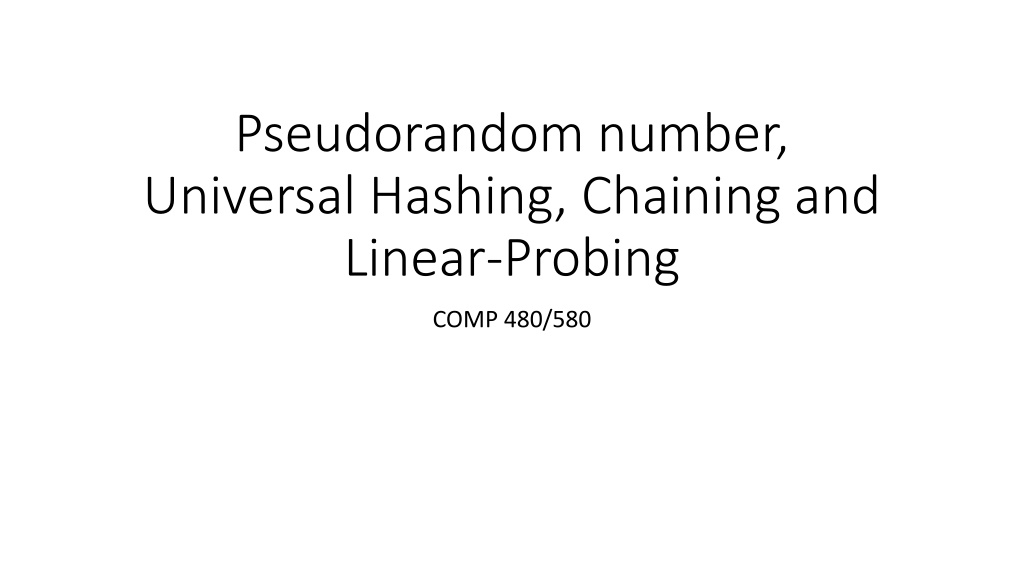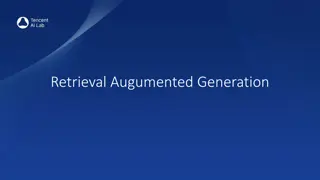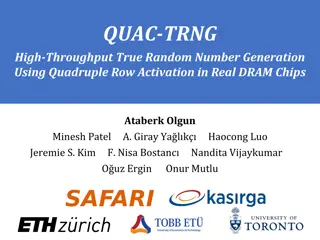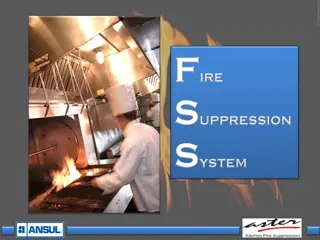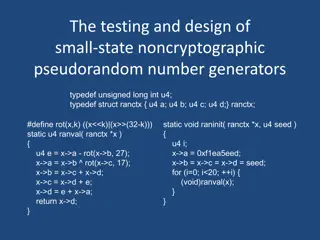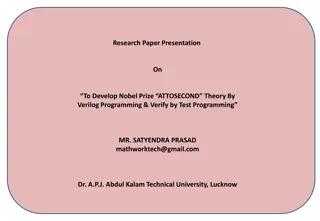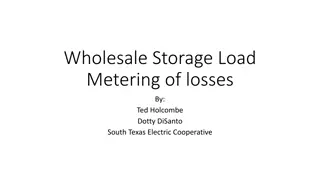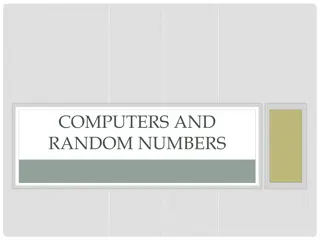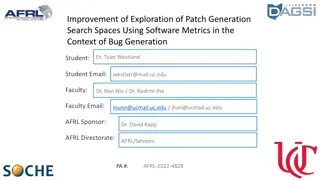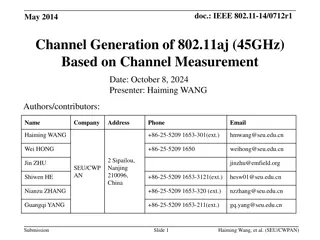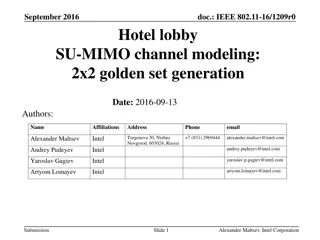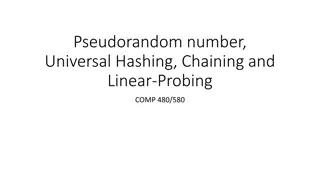Pseudorandom Number Generation Techniques
This content covers various methods for generating pseudorandom numbers, including the Middle-Square method, the Weyl's Sequence idea, and Universal Hashing. It explains how pseudorandom number generators work and the concepts behind them, such as seeding and hashing. The text also discusses the importance of generating random numbers for simulations and cryptographic applications.
Download Presentation

Please find below an Image/Link to download the presentation.
The content on the website is provided AS IS for your information and personal use only. It may not be sold, licensed, or shared on other websites without obtaining consent from the author.If you encounter any issues during the download, it is possible that the publisher has removed the file from their server.
You are allowed to download the files provided on this website for personal or commercial use, subject to the condition that they are used lawfully. All files are the property of their respective owners.
The content on the website is provided AS IS for your information and personal use only. It may not be sold, licensed, or shared on other websites without obtaining consent from the author.
E N D
Presentation Transcript
Pseudorandom number, Universal Hashing, Chaining and Linear-Probing COMP 480/580
How are sequence of random numbers generated? Natural Experiments Based Start flipping real coins. Measure some physical phenomenon that is expected to be random and then compensates for possible biases in the measurement process. Example sources include measuring atmospheric noise, thermal noise, and other external electromagnetic and quantum phenomena. Pseudorandom Number Generator (PNG) Seed based. Deterministic and will give the same sequence if the seed is same.
Idea behind PNG Middle-Square method (John von Neumann in 1949) Start with n-digit seed. (Say 1111) Square it (1234321 = 01234321) . (will be 2n digits, if not pad leading zeros.) Report the middle n numbers as the next sequence. (2343) Issues? N needs to be even.
Based on Weyls Sequence Idea The sequence of all multiples of such an integer k, 0, k, 2k, 3k, 4k, is equ-idistributed modulo m if m is relatively prime to k. That is, the sequence of the remainders of each term when divided by m will be uniformly distributed in the interval [0, m). The following C code is an example d += 362437; In this case, the seed 362437 is an odd integer. (Why?)
Simple Interview Question Given an array of n integers, remove duplicates Comparison Based: O(?2) Sorting Based O(n log n) Hashing Based. O(n). Hash tables. (if we can map n integers uniquely to [0-n-1] then in O(n) memory)
Hashing Basics Hash Function: Takes an object O and maps it to some discrete range ? [0 ?]. Perfect Hash Function: if ?1 ?2 ? ?? ?1 ?2 Guaranteed. O(1) search. How to construct such functions? Given a dynamic collection of objects, allow for efficient searching and addition.
Universal Hashing (Approximate) Starting point Design :??????? [0 ?] such that If ?1 ?2? ?? ?1 ?2 most of the time. h is cheap to compute and requires almost no memory. Or probability of h(?1) = h(?2). If h is perfectly random, then it is 1/N Starting point of the definition. Getting Pr(h(?1) = h(?2)) < 1/N requires memory. (Not input oblivious)
2-Universal Hashing Family. A set (family) of hash function H is 2-universal if for all x, y U such that ? ? we have Pr ?( ? = (?)) 1/N where h H means that h is selected uniformly at random from H.
The hash family H Choose a prime P > N Let, ?,?(x)= ?? + ? ??? ? ??? ? The family is H = { ?,?| ? 1,2, ,? 1 and ? {0,1,2, ,? 1}} H is a set that contains P(P-1) Functions for the form h x = ) ? ??? ? ??? ? Fact: For any ?, ? Pr ?( ? = (?)) < 1/N Under uniform sampling of function h from the set H. Problem: Sampling before calculating hash function will break h(x) = h(x). ( ?? +
Law of Deferred Decision in Action Choose a prime P > N Draw uniformly ? ~ 1,2, ,? 1 and ? ~ {0,1,2, ,? 1} Declare h(x) = ?? + ? ??? ? ??? ? Hash function is fixed! (but we can still claim) Fact: For any ?, ? ??( ? = (?)) < 1/N under the sampling of a and b h(x) = h(y) if x = y is guaranteed!
The hash family H Choose a prime P > N Let, ?,?(x)= ?? + ? ??? ? ??? ? The family is H = { ?,? | ? 1,2, ,? 1 and ? {0,1,2, ,? 1}} Claim: For any ?, ? Pr ?( ? = (?)) < 1/N How about Pr ?( ? = ? = (?))
How to sample h uniformly from H Sample and fix. Randomly generate a and b independently and uniformly and store them. ? = ?? + ? ??? ? ??? ? Allows us to compute h(x) and h(y) just via communication of a, b, P Principle of deferred decision A probabilistic algorithm makes several stochastic choices based on coins (random outcomes). The following are equivalent Either flip the coins during the experiments. (deferred) Or flip the coins in advance and reveal their outcomes to algorithm when needed.
Class Exercise: Mod operation is slow ? = ?? + ? ??? ? ??? ? a should not divide P Alternatives?
Example 0 1 2 3 4 5 6 7 8 9 key space = integers Table Size = 10 41 h(K) = K mod 10 Insert: 7, 18, 41, 94 7 18 94 17
Example 0 1 2 3 4 5 6 7 8 9 key space = integers TableSize = 10 41 h(K) = K mod 10 94 Insert: 7, 18, 41, 94 7 18 18
Collision Resolution Collision: When two keys map to the same location in the hash table. Two ways to resolve collisions: 1. Separate Chaining 2. Open Addressing (linear probing, quadratic probing, double hashing) 19
Example: Separate Chaining. key space = integers TableSize = 10 0 1 2 3 4 5 6 7 8 9 ptr 41 h(K) = K mod 10 Insert: 7, 41,18, 17 ptr ptr 17 7 18 20
Chaining with 2-universal hashing? We insert m objects into array of size N using 2-universal hashing. What is the worst-case searching time of an object? What is the expected value of searching time with N array size and m objects inserted? < 1 + (m-1)/N
Issues with Chaining? Linked List
Idea behind Probing Probe sequence: 0th probe = h(k) mod TableSize 1th probe = (h(k) + f(1)) mod TableSize 2th probe = (h(k) + f(2)) mod TableSize . . . ith probe = (h(k) + f(i)) mod TableSize Searching Keep probing until you find empty spot. Return if match 23
Linear Probing F(i) = i Probe sequence: 0th probe = h(k) mod TableSize 1th probe = (h(k) + 1) mod TableSize 2th probe = (h(k) + 2) mod TableSize . . . ith probe = (h(k) + i) mod TableSize 24
Probing or Open Addressing Insert: 38 19 8 109 10 0 1 2 3 4 5 6 7 8 9 Linear Probing: after checking spot h(k), try spot h(k)+1, if that is full, try h(k)+2, then h(k)+3, etc. 25
Probing or Open Addressing Insert: 38 19 8 109 10 0 1 2 3 4 5 6 7 8 9 8 109 10 Linear Probing: after checking spot h(k), try spot h(k)+1, if that is full, try h(k)+2, then h(k)+3, etc. 38 19 26
Quadratic Probing Less likely to encounter Primary Clustering F(i) = i2 Probe sequence: 0th probe = h(k) mod TableSize 1th probe = (h(k) + 1) mod TableSize 2th probe = (h(k) + 4) mod TableSize 3th probe = (h(k) + 9) mod TableSize . . . ith probe = (h(k) + i2) mod TableSize 27
Double Hashing f(i) = i * g(k) where g is a second hash function Probe sequence: 0th probe = h(k) mod TableSize 1th probe = (h(k) + g(k)) mod TableSize 2th probe = (h(k) + 2*g(k)) mod TableSize 3th probe = (h(k) + 3*g(k)) mod TableSize . . . ith probe = (h(k) + i*g(k)) mod TableSize 28
